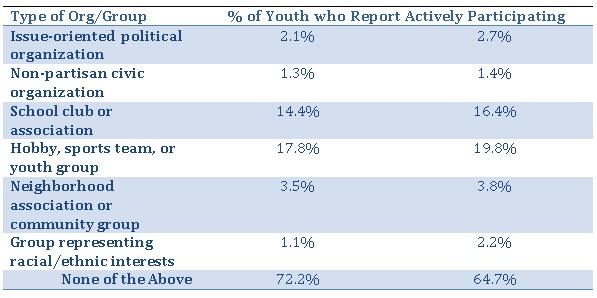Group Opportunities Lacking for Youth, or Young People are not Formal “Joiners”
In the pre-Web 2.0 Era, membership in groups and organizations was an important measure of civic engagement. Groups and associations can be sites where young people learn job skills and civic skills, build networks, and potentially meet those with different experiences from themselves. In previous CIRCLE work, we have reported the decline of young people’s membership in unions, political parties, and religious organizations.
We recently released polling data about young people’s thoughts and activities so far in this election cycle. Our poll shows that overall, group membership is low among youth. We focus on differences by educational background because education is often a powerful predictor of how people engage. Although youth with college experience and those who have never attended college do not differ much in group membership, more youth with college experience have actively participated in many types of organizations (with the exception of a veterans’ group). In two separate questions, we asked about the various types of groups youth are participating in:
The two tables above should not be interpreted to suggest that youth are choosing not to participate. Our recent research on the experiences of non-college youth suggests that many youth participate informally, want to be engaged, but don’t see opportunities to participate. Youth may contribute to their communities without thinking of themselves as members of a group.
Additionally, these numbers may reflect the changing nature of group membership (see Theda Skocpol’s research in this area) and the rise of online engagement. What might it mean to “actively participate” in an organization whose email list you are on?
Implications
- Youth organizations and religious institutions draw the largest share of respondents. Either they provide the most opportunities for youth, or youth identify most and care most about them. (We found that non-college youth are most interested in reaching out and helping people younger than themselves.)
- The k-12 school years are an important time to join groups for youth who may not immediately go on to college and may therefore become disconnected from institutions and organizations
- If we want to promote more political participation, then more political opportunities would likely help
- About a fifth of youth (18-29) have children. In our non-college youth focus groups, we heard that one way youth were participating was through their childrens’ schools: this may be another pathway into participation.








September 5th, 2012 at 12:20 pm
Thanks for sharing the data. It’s extremely interesting to see what we can learn about youth and their willingness to join associations nowadays, as compared to the pre-Web 2.0 era, like you said.
September 30th, 2013 at 3:52 am
[…] serving as an assassin for one of them. His fear of culture led him to go to great lengths to stay this is a good resource unseen and hidden within the shadows. With his mask, he could hide his disfigured features to those […]